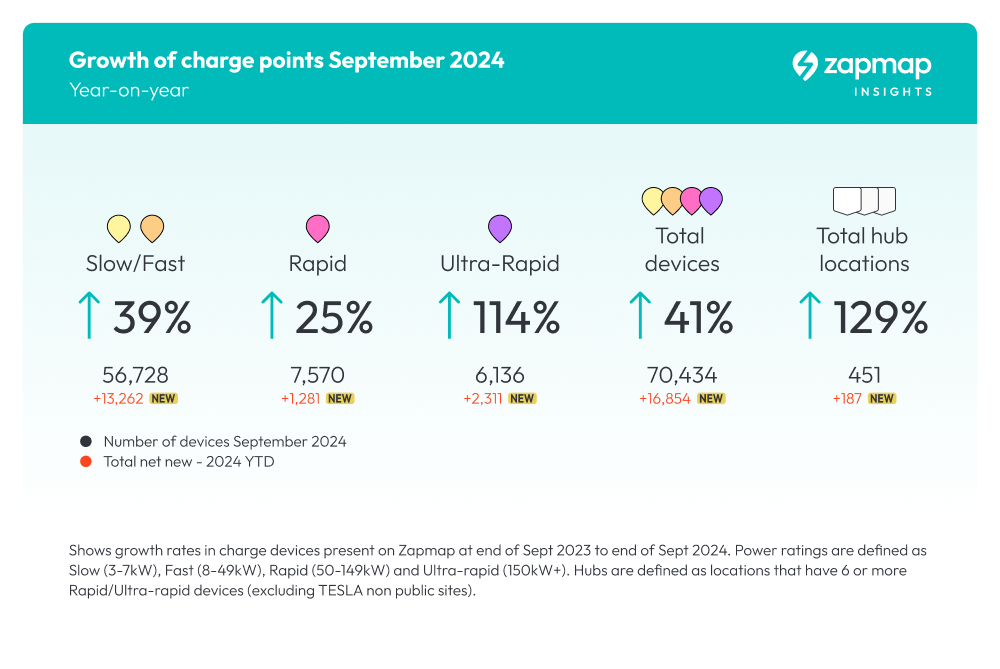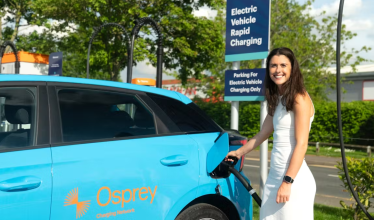The number of public charging devices has surpassed the 70,000 mark, continuing the rapid growth of the country’s EV charging infrastructure. This milestone comes just five months after Zapmap recorded 60,000 public chargers in April 2024, marking a significant achievement in the transition to electric mobility.
As of September 2024, there are now 70,434 public charging devices available to EV drivers in the UK, representing a 41% year-on-year increase compared to September 2023, when 49,882 devices were recorded.

Building on the record levels of growth seen in recent months, and as a result of ongoing investment from charge point operators, the pace of installation has continued to accelerate:
- In 2022, an average of 730 new devices were installed per month.
- In 2023, this figure nearly doubled to 1,387 devices per month.
- In 2024 so far, the average monthly installation rate has climbed to 1,872 devices per month.
According to data from Zapmap, the 70,000th public charging device was installed in September 2024. Operated by charging network evyve, the 70,000th charging device to be installed was a rapid charging device located in the car park of the New Pippin, a Greene King pub in Coventry. Specialising in ‘destination’ charging at locations like retail and leisure outlets, business parks and restaurants, eyvye achieved the ‘Up and Coming Network’ accreditation in Zapmap’s 2024 satisfaction rankings, as chosen by EV drivers in Zapmap’s annual EV charging survey.
James Moat, CEO of evyve, said:
We're proud to be part of this milestone, reflecting the collective dedication of the entire EV charging sector to expanding accessible infrastructure. Reaching 70,000 devices on Zapmap highlights the industry's commitment to making the switch to electric as seamless as possible!
A notable trend is the growth in the number of ultra-rapid chargers, capable of delivering 100 miles of range in just 15 minutes, which has shown 114% year-on-year growth, from 2,869 in September 2023 to 6,136 in September 2024. Ultra-rapid chargers play a key role in supporting long-distance travel, making them essential for drivers who want to recharge quickly while on the go.
Similarly, the number of charging hubs – locations with six or more rapid or ultra-rapid charging devices – has more than doubled, rising from 197 hubs in September 2023 to 451 hubs in 2024. This 129% increase demonstrates charge point operators responding to demand from EV drivers to create dedicated, high-power charging zones that offer charging convenience and confidence to drivers on long journeys.
Melanie Shufflebotham, Co-founder & COO of Zapmap, commented:
"Reaching 70,000 public chargers is a testament to the collective efforts of the EV industry to accelerate the electrification of transport in the UK. This number covers many different charging use cases from low powered on-street chargers to destination chargers at hotels and 150kW+ charging hubs. Whilst requiring different levels of investment, each reflects charge point operators’ significant commitment to providing EV drivers with the public charging infrastructure they need to confidently travel and charge their vehicles anywhere.
"With more charge points than ever on the Zapmap app, and more being installed at a record rate, EV drivers are able to find, use, and pay for their charging with increasing ease and confidence across the UK."
New charging hubs are being deployed across motorways and key travel routes, with Osprey, InstaVolt, and MFG charging networks installing the largest number of new hubs in 2024. Recent examples include Osprey’s hub with eight ultra-rapid EV chargers installed at Hirst's Farm Shop & Café in Great Yarmouth, and InstaVolt opening its latest EV charging hub at Lydiard Fields near Swindon, just off junction 16 of the M4, one of Wiltshire’s busiest junctions, with 12 ultra-rapid charging bays, including six accessible bays, and easy access to a host of amenities for busy commuters and visitors.
At the less powerful end of the spectrum, on-street charging infrastructure currently makes up over a third of all the charge points in the UK, with Greater London still accounting for the majority (72%) of these on-street charge points.
Dan Caesar, Launch CEO of Electric Vehicles UK said:
“The staggering rise in publicly available electric vehicle charging points in just the last few months is testament to an industry that is responding at pace to growing end-user demand. This rollout is critical to consumer confidence, not least in an era of misinformation in which EV drivers’ largely positive experience of electric cars is not reflected accurately in the media.
Consistently when surveyed, more than 9 out of 10 EV drivers will not return to combustion engine cars, and the increasing availability of charging points will only improve that ratio, and pave the way to a zero emission (from the tailpipe) future.”
In a new report led by Cenex and Vauxhall, in collaboration with Zapmap, Field Dynamics and Experian, new charging metrics have been developed in order to track the progress of Local Authorities across the country with their close to home provision. According to the metrics, outside of London, households reliant on public charging in Brighton and Hove have the best supply and distribution of charge points, whilst Nah-Eileanan Siar, Coventry and Blaenau Gwent are the leading Scottish, English and Welsh Local Authorities. As charge points from the government’s LEVI (local electric vehicle infrastructure) fund start to be deployed, on-street provision across the UK should increase significantly.
A further third of the UK’s overall provision is located in car parks across the UK (includes a variety of public car parks, retail car parks, supermarkets and park and ride). With the number of these devices rising by nearly 50% over the last year (now 21,178 devices in place). Operators are rolling out a mix of lower powered (<50kW) devices and higher powered (50kW+) devices at these sites, as different provider strategies are developing. For example, at supermarkets 43% of devices installed there are 50kW+ today, compared to only 34% a year ago.
With over 70,000 public chargers across 35,810 locations now available, of which over 13,000 are rapid or ultra-rapid across 5,762 locations, the UK is well on its way to building the robust charging network needed for mass EV adoption. Zapmap will continue to play a central role in this growth, offering key data and insights to ensure that charging points are installed in the right locations to serve the nation’s EV drivers efficiently and reliably.



